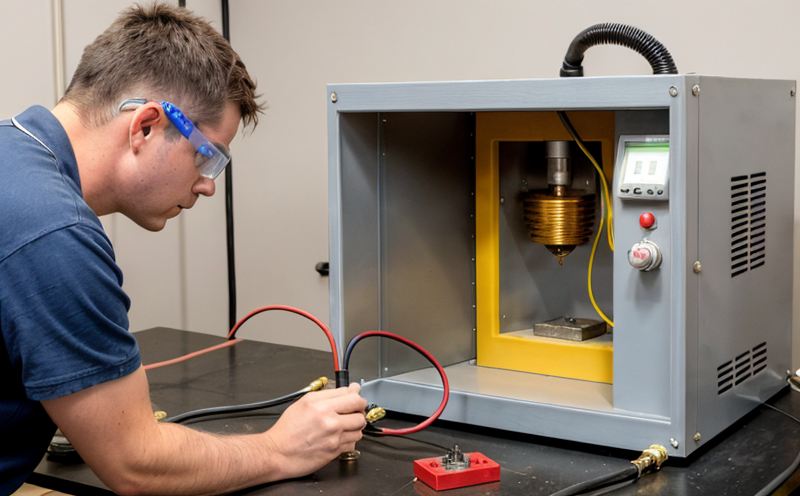ISO 60404-6 Magnetic Hysteresis Loop Measurement
The ISO 60404 series of standards defines a set of procedures for the measurement and evaluation of magnetic properties in ferromagnetic materials. This service focuses on the specific test method described in ISO 60404-6, which involves the determination of the magnetic hysteresis loop for soft magnetic materials and alloys.
The magnetic hysteresis loop is a fundamental characteristic that helps to evaluate the quality and performance of ferromagnetic materials. This test measures how a material responds to an alternating magnetic field, providing insights into its coercivity, saturation magnetization, and energy product (BHmax). These parameters are crucial for understanding the material's suitability in various applications, such as transformers, sensors, and actuators.
The measurement process involves subjecting a sample of the material to an alternating magnetic field. The resulting loop represents the relationship between the applied field strength (H) and the induced magnetization (B). By analyzing this curve, engineers can determine critical points like remanence (Br), saturation magnetization (Ms), and coercivity (Hc).
Preparation of the sample is essential to ensure accurate results. The specimen should be free from defects that could affect magnetic properties, such as grain boundaries or impurities. After preparation, the sample undergoes a series of tests using high-precision instrumentation capable of generating precise magnetic fields and measuring minute changes in magnetization.
The test setup typically includes a vibrating sample magnetometer (VSM) or a superconducting quantum interference device (SQUID). These instruments provide highly accurate measurements that are crucial for ensuring compliance with international standards. The data collected during the test is then analyzed to generate a comprehensive report detailing the magnetic properties of the material.
The results of this testing can be used in various ways, including quality control, research and development, and procurement decisions. By understanding the magnetic behavior of materials, manufacturers can optimize their processes and ensure that they meet strict performance requirements.
For instance, in the production of electrical components like transformers, accurate knowledge of a material's magnetic properties is essential for optimizing design and ensuring efficient operation. Similarly, in research environments, this data provides valuable insights into the fundamental behavior of materials under different conditions.
Scope and Methodology
The scope of ISO 60404-6 is to provide a standardized procedure for measuring the magnetic hysteresis loop of soft magnetic materials and alloys. This service covers the entire process, from sample preparation to data analysis and reporting.
The methodology involves several key steps:
- Sample preparation: Ensuring the material is free from defects that could affect magnetic properties.
- Magnetic field generation: Applying an alternating magnetic field to the specimen.
- Data acquisition: Using high-precision instruments like a VSM or SQUID to measure magnetization changes.
- Data analysis: Processing the acquired data to determine critical points on the hysteresis loop.
- Reporting: Producing a detailed report that includes all relevant parameters and their interpretations.
The use of standardized procedures ensures consistent results, which is vital for quality control and compliance with international standards. This service adheres strictly to ISO 60404-6, ensuring accurate and reliable magnetic property data.
Industry Applications
- In the automotive industry, materials like iron-nickel alloys are used in electric vehicles' motors. Accurate measurement of their magnetic properties ensures efficient operation and energy efficiency.
- In power generation, transformers rely on soft magnetic materials for optimal performance. Testing these materials helps to optimize design and ensure safety standards are met.
- In the production of sensors, accurate knowledge of a material's magnetic behavior is crucial for precise readings. This testing supports the development of more reliable and accurate sensor technology.
- In research and development, understanding the fundamental properties of materials under various conditions is essential. This service provides valuable data that can be used to advance scientific knowledge.
The ability to accurately measure magnetic hysteresis loops using ISO 60404-6 ensures that materials meet stringent performance requirements across multiple sectors. By leveraging this testing, manufacturers and researchers can ensure their products are of the highest quality and comply with international standards.
International Acceptance and Recognition
The ISO 60404-6 standard is widely recognized and accepted in the global metallurgical community. Its widespread adoption ensures that results obtained from this testing method are universally comparable, facilitating international trade and collaboration.
Countries around the world use this standard to ensure consistency in magnetic property measurements. This uniformity allows for easier integration of products into global supply chains, enhancing interoperability and compatibility across different regions.
Recognized laboratories that offer this service include some of the most reputable institutions globally. Their adherence to ISO 60404-6 ensures high-quality testing and reporting, which is crucial for maintaining a competitive edge in the international market.





